The main goal of your landing page is to drive conversions—ideally, you are trying to convert prospects into customers. However, not everyone who visits your landing page or website is ready to convert.
Many potential subscribers may not be ready to buy what you are selling, but want to stay engaged and connected with you before they make the definitive decision of converting. They may be willing to give you their email address in exchange for time, thus qualifying them as leads.
A lead is just a future conversion that hasn’t happened yet. To ensure that the lead does eventually convert, you’ll need to nurture those leads with an email newsletter.
So, what does a successful newsletter look like?
In this article, we’ll discuss what an email newsletter is, how email marketing works, and best practices for creating effective email newsletters.
What is an email newsletter?
An email newsletter is a regularly scheduled email sent to newsletter subscribers who have opted in (via a signup form) to receive communication from your brand, including updates, news, stories, articles, offers, and more valuable information.
The purpose of email newsletters is to keep subscribers informed and engaged, with the general goal of building a relationship and cultivating a community with your target audience.
It’s not just an email. Newsletters are an essential part of email marketing strategies, as they provide a way to promote products or services, create brand awareness, and engage with your community beyond your website and social media platforms.
For example, The Washington Post uses its daily newsletter, The Post Most, to showcase trending website articles that other readers are loving.
By offering its email subscribers a sampling of the type of content they can expect to find on the publication’s website, they hope to entice readers to become paid subscribers.
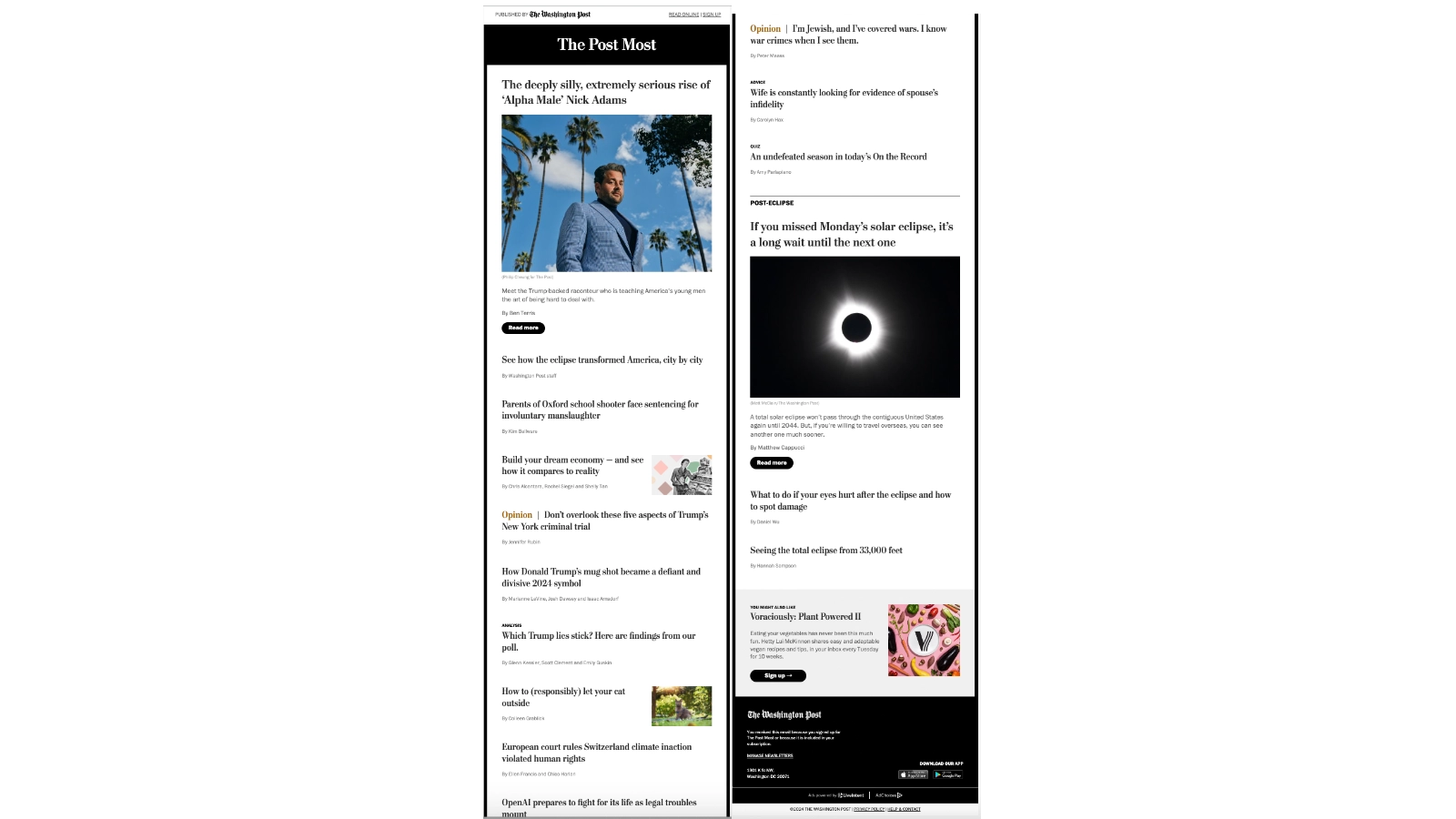
How do email marketing campaigns help nurture audiences?
Regularly sending communications to your email subscribers (without flooding their inboxes) helps keep your brand top of mind and gives you the chance to position yourself as a thought leader in your space.
Newsletter content is not solely about selling to your audience—it’s about helping your readers understand the voice of your brand. Newsletters (starting with your subject lines!) are a place to have discussions with subscribers, asking questions, telling stories, and helping them relate to your brand to build a loyal following that eventually leads to a conversion or sale.
For creators, newsletters are appealing because they typically deliver a high ROAS. They are cheap to make and send and tend to pay off, reportedly seeing an estimated ROI of $40 for every $1 spent.
Know what to say: Define your email newsletter goals and guidelines
As with any marketing strategy, email marketing requires thought behind what each email newsletter will entail. To maintain consistency with each email newsletter you’ll send, you must define your goals and guidelines.
Before you create an email, ask yourself questions like:
- Where will my email signup forms live?
- What do I want to accomplish with this newsletter? Will this newsletter be another avenue for monetization?
- When do I want to send my newsletter?
- What do I want my email frequency to be?
- How can I use my subject lines to hook newsletter subscribers from the start?
- What will the tone of my newsletter be?
- Will my newsletter feature curated content or original content?
- What is the unique value proposition I can offer in my newsletter versus others in my industry?
- How will I segment audiences?
- Do I want to use my newsletter to increase my website traffic?
- What key performance indicators will I use to measure the success of my email marketing campaign?
The most successful email newsletters create a lasting impression with attention-grabbing, thought-provoking, and interesting (and quick) to-read content. They are not too sales-driven, impersonal, or corporate. And their subject lines succeed in setting expectations.
When you figure out what resonates with your leads and how you want to portray your brand through your email messaging, you can use that as a foundation or template to build your newsletter time after time.
Once you start consistently sending out your email newsletter, you can analyze your campaign metrics and understand where iterations can be made – perhaps your monthly cadence is not enough and a weekly newsletter will perform better. Maybe an earlier- or later-in-the-day send time will result in a better click through rate. Perhaps your subject lines are too long and are misleading your audience.
Let’s dive deeper into your email marketing strategy.
How to develop an email marketing strategy for a newsletter
After identifying your goals and your KPIs, here’s what you need to do to develop a comprehensive email newsletter strategy:
- Choose an email management system. The right email marketing tools can make a big difference in the success of your campaigns. Email marketing software can run the gamut from informal to sophisticated, depending on your budget and your needs (if you’re just getting started, a free version of email marketing tools might be worth trying). An email management system will ideally enable you to plan and organize your content (similar to an editorial calendar), deploy your content to your distribution lists, and give you insights into the performance of your email campaign.
Think you can get by without an email service provider? Before you decide that this is something you’d rather take on on your own, understand that email marketing software makes it more likely that your newsletter will actually end up in your subscribers’ inboxes instead of in spam and gives you a reliable way to be consistent with your sends. An email service provider can offer peace of mind, especially if you have a large number of subscribers on your lists.
- Provide value every time. Think of how many emails we all receive on a daily basis. Our inboxes are saturated. If people are taking their time to complete signup forms, you want to ensure your newsletter content is worth their time and will help them somehow.
Because you are ultimately trying to drive conversions, you should create an email that includes call-to-action buttons to nurture your lead further down your funnel. We recommend connecting all email offers with a dedicated landing page that has cohesive messaging and allows your readers to get what they need quickly and effectively.
This Salesforce Marketing newsletter aims to educate readers on how to grow customer journeys, with more information available in a downloadable guide.
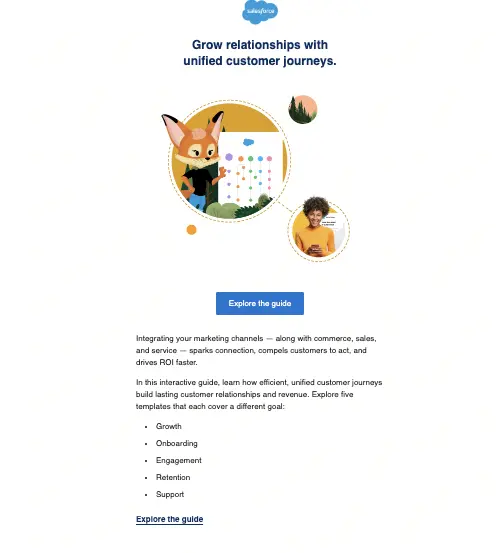
Clicking the email newsletter CTA for the guide brings the reader to a dedicated landing page where they see the same messaging about those customer relationships and can easily find the CTA button to download the guide. Plus, additional related CTAs give readers even more opportunities to convert.
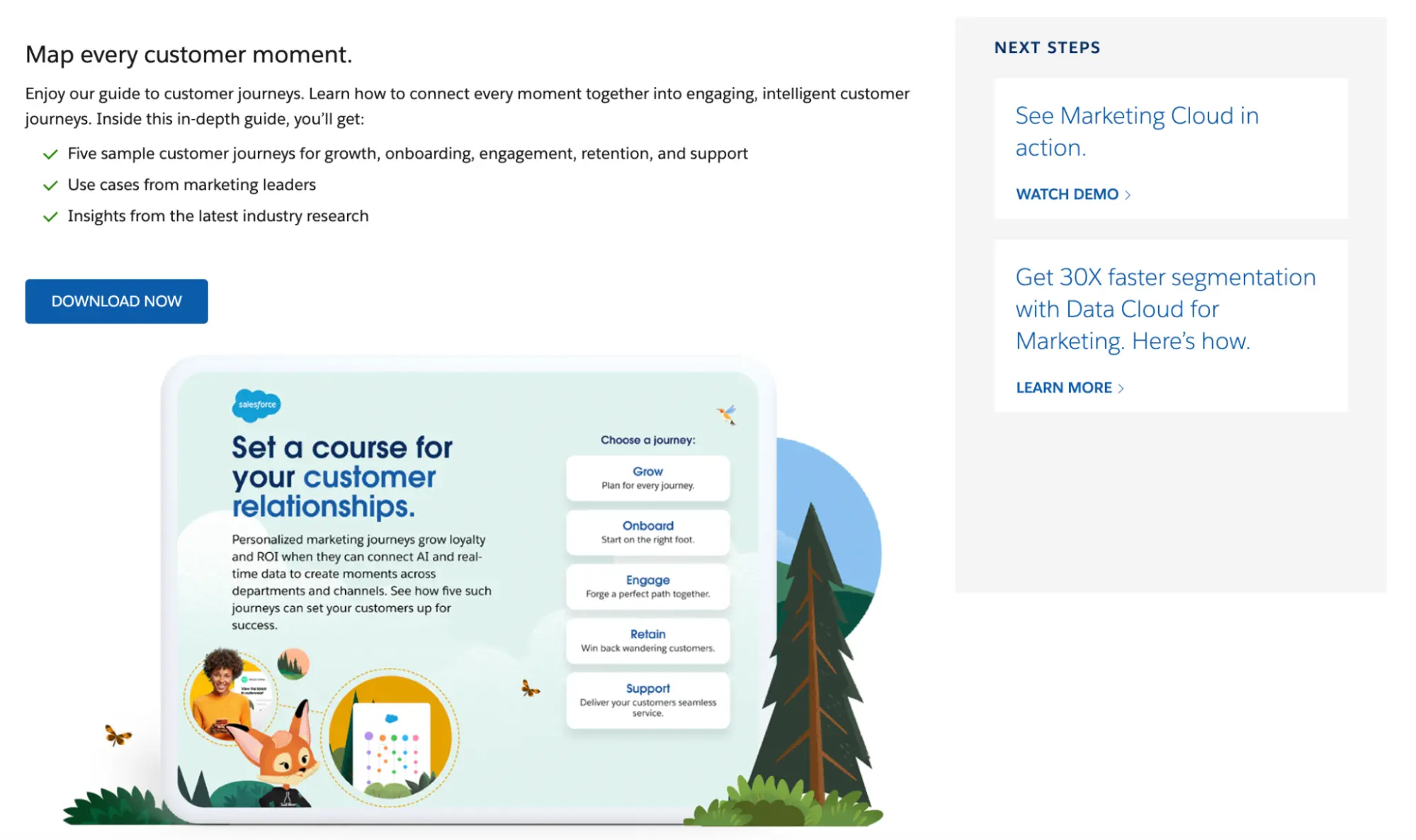
-
Segment your audience. Email segmentation is important because you want your readers to see the right message at the right time. When you segment your audience, you can create an email that is more targeted and increase your potential ROAS.
Various factors can affect how your email will perform and you can use these factors to build your distribution lists. Segmentation factors include:
– Demographics
– Geographic location
– Consumer behavior
– Buyer personas
– Stage of the funnel/customer journey
– B2B or B2C -
Run A/B tests. Think of your newsletter content, especially in the beginning stages, as an experiment. Iterations are key. To figure out what is working and what can be improved, keep every detail in mind.
Did you use the most engaging subject line? Are you showcasing your most dynamic content? Are your readers using both desktop and mobile devices? Trying out a different subject line, different layout, or bolder design, making sure to optimize for mobile devices, and testing out different high quality content are all ways to experiment and figure out what resonates most with your target audience.
Using an email marketing tool that allows you to A/B test will give you the deep insights you need to maximize performance of your campaigns.
-
Track your metrics.Once you create a newsletter, it’s time to get down to business. Tracking your KPIs and making changes to your email newsletter content based on data will help you create highly effective campaigns.
Specifically, metrics like open rate, click through rates, number of clicks, number of subscribers, completed sign up forms, and more will give you an idea of what your readers are finding most engaging.
10 email marketing newsletter examples from DTC and SaaS brands
Here are 10 email newsletters that provide valuable content to their subscriber list:
1. Welcome email newsletter
Food52 is a website that curates recipes, home goods, and crafts for anyone who likes to be in the kitchen. When new subscribers sign up, they are greeted with a welcome email that outlines what they can expect from Food52 and offers a discount code to use in their shop.
This email newsletter does a good job of immediately making the reader feel like they are part of the community and enticing them to convert into a paying customer.
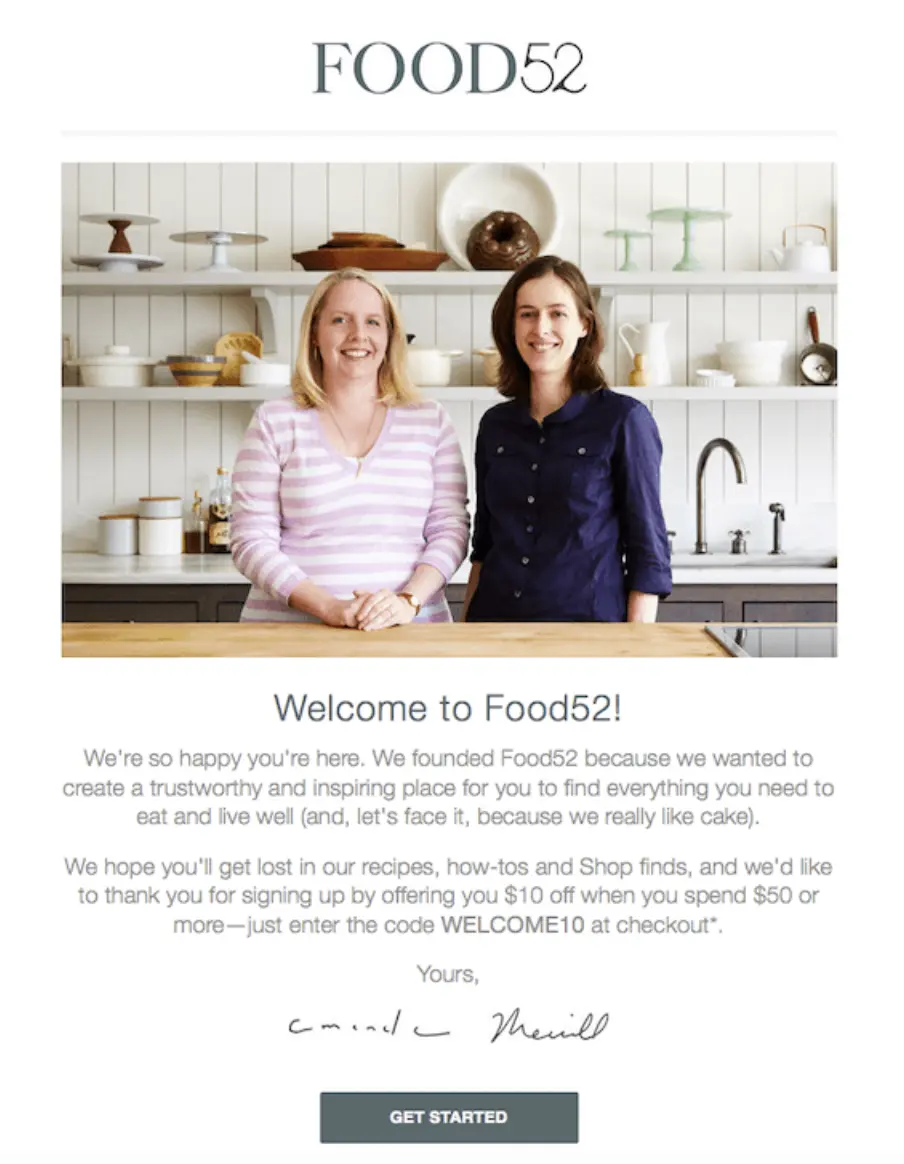
2. Speaking to the right subscriber list
In this example of an email newsletter from Buffer, the copy is clearly written for a specific segment of their target market. Using slang like ‘stan’ and a pop culture reference to Zendaya make it clear that the audience for this newsletter skews younger and shows that Buffer creators have done their due diligence to create a newsletter that resonates.
We also like that they include a breakdown of what to expect in that day’s newsletter.
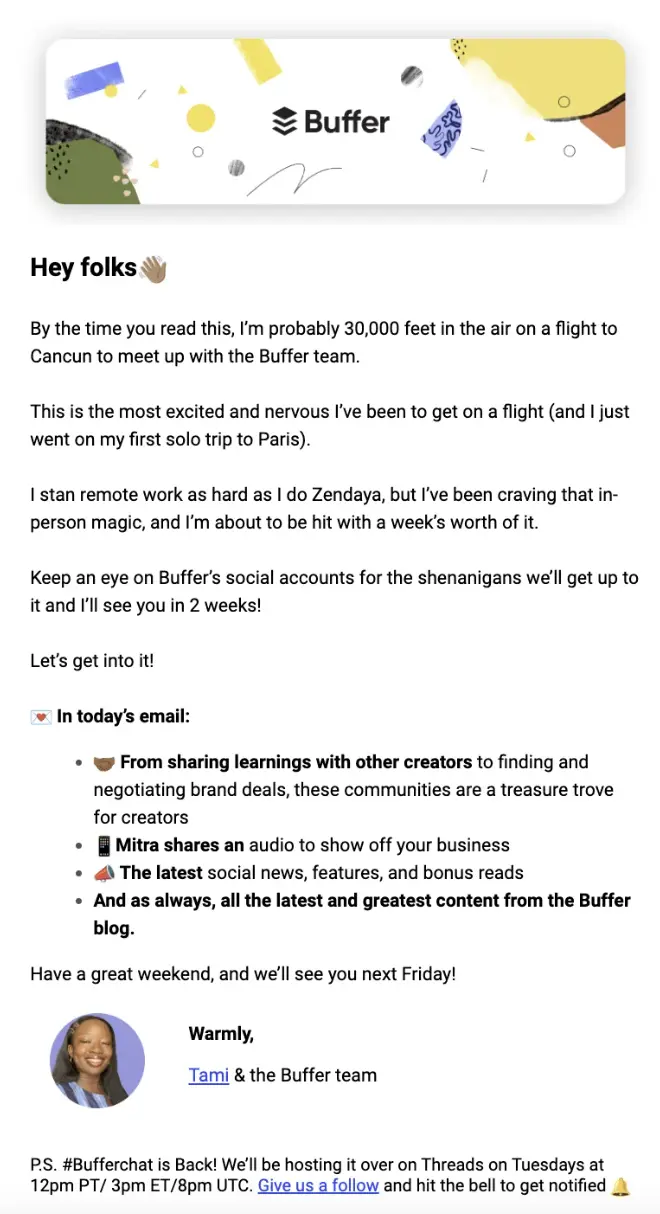
3. Thought-leadership content
SEO experts at Moz understand that despite the fact that people are so busy, they need to stay in the know. Especially when it comes to something as ever-changing as optimal SEO practices.
They created their semi-monthly email newsletter called Moz Top 10 to share the 10 most valuable articles about SEO and online marketing that they source from around the web. By offering high-quality thought-leadership content, they hope to gain the trust of their readers and convert them into loyal customers.
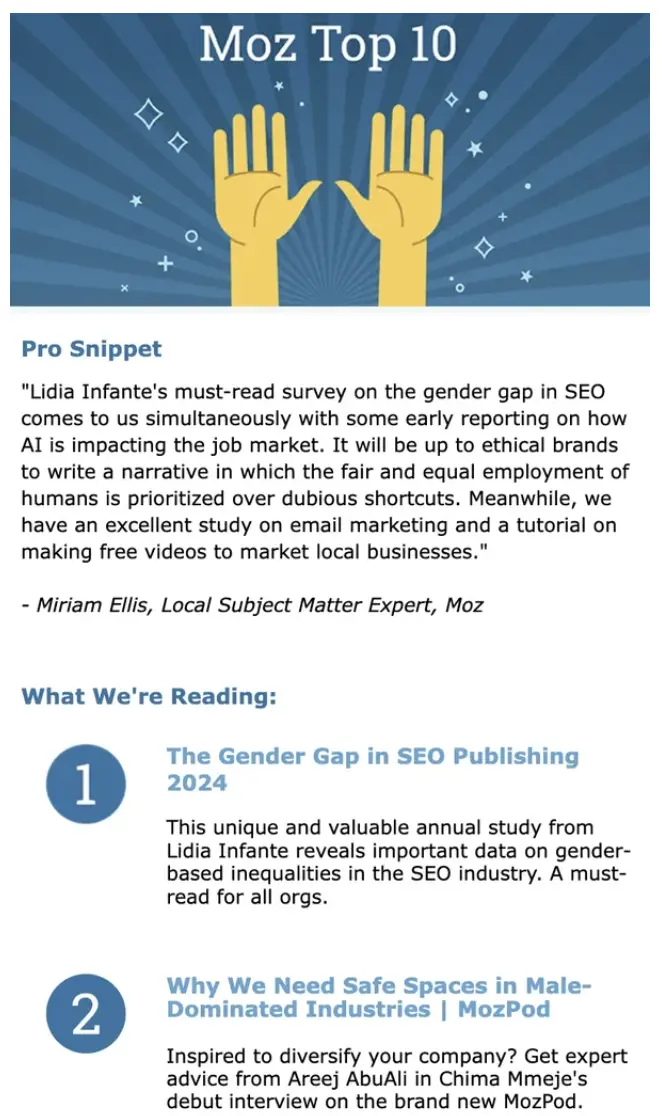
4. Mobile-friendly news
A lot of people wake up, grab their phone, and start reading emails before they’ve even had their morning cup of coffee.
Marketing Brew wanted to create an email newsletter that capitalizes on that by serving industry news and updates on a daily basis. The fact that their designs are easily viewable on mobile devices makes it highly likely that readers will commit to that email newsletter every day, regardless of where they are.
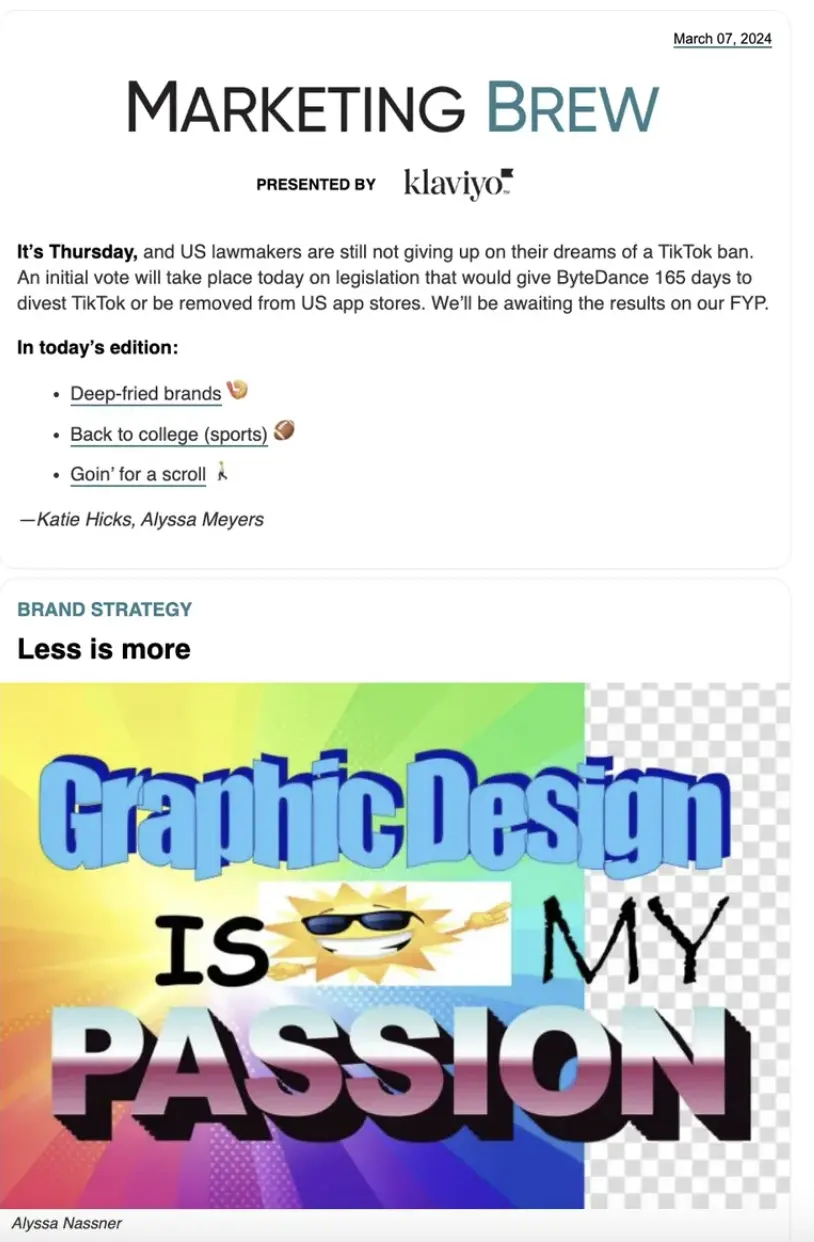
5. Blog round-up
Want to get more eyes on that well-crafted blog post you wrote? A weekly newsletter rounding up recently published articles from your website is a good way to ensure that your readers don’t miss any valuable content.
Grammarly employs this tactic with their email newsletter, which also includes writing tips, grammar facts, and more. And, from their very first welcome email, they make sure to stick to their brand ethos mixing grammar lessons with a good dose of humor.
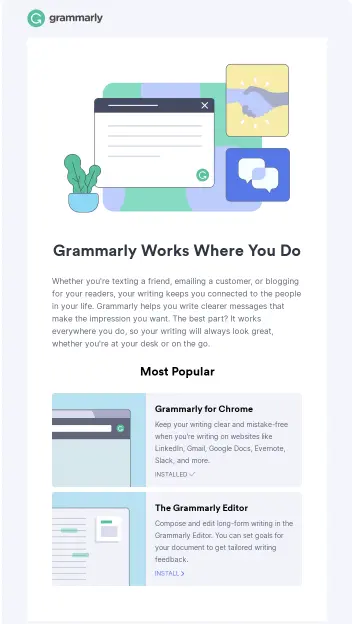
6. Daily content
Not every email newsletter will benefit from having a daily cadence. For many companies, that volume of email sends can backfire, feeling too spammy for readers and getting too overwhelming to manage for creators.
The Skimm gets it right. They provide a highly popular daily newsletter that curates top news stories of interest to readers. It is an effective email campaign that educates people about what’s going on in the world while building a reputation as a credible, reliable source for daily news. Plus, it’s equally skimmable on desktop or mobile devices.
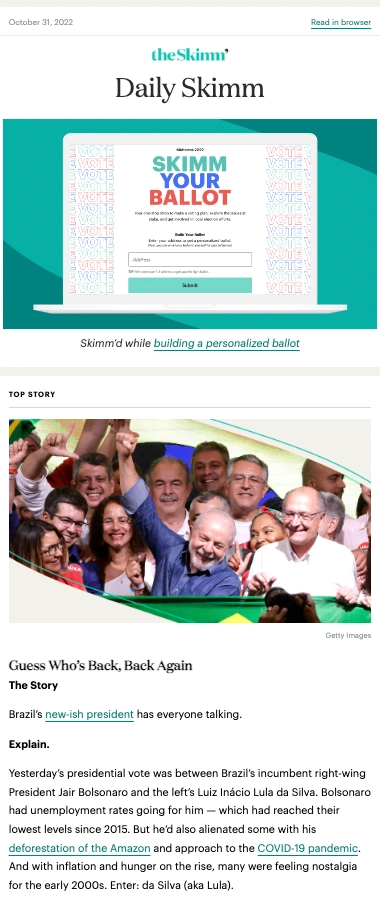
7. Leading with visuals
The marketers over at The New York Times know what they’re doing. Whether it’s delivering news, introducing fun ways to exercise our brains, or helping us decide what to make for dinner, they know how to attract new subscribers with one successful email campaign after another.

8. The reader chooses the cadence
People turn to TechCrunch as a dependable source for important tech news. And they have plenty of news to share. Knowing that, they offer 10 newsletters to opt into, some with a daily cadence, some with a weekly cadence, and all tailored to a specific topic (think fintech, crypto, or morning updates).
This puts readers in control of the content they will receive and makes the experience feel more personalized, which is a smart way for the publication to communicate their general approach to interacting with their subscribers.
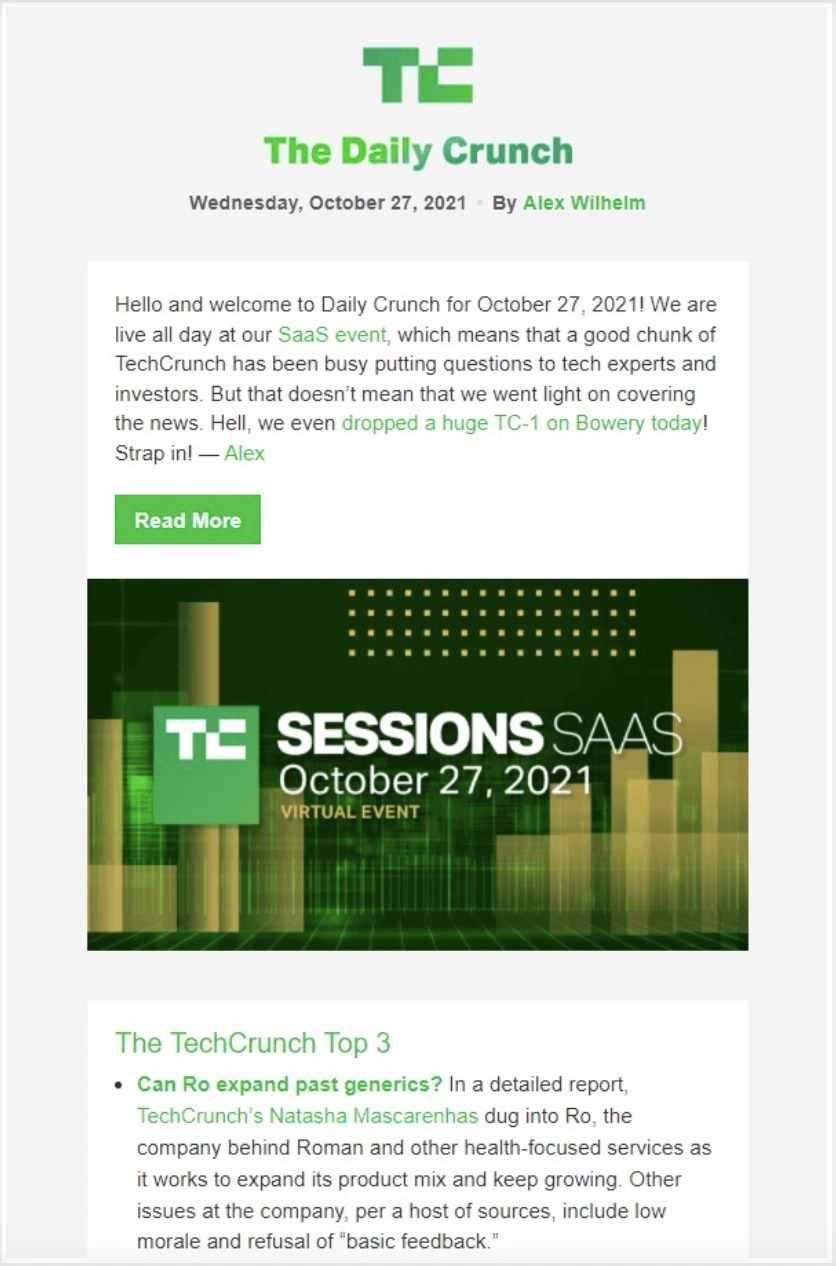
9. Mixing business with pleasure
Bloomscape is a direct-to-consumer (DTC) brand that uses their newsletter to support their ecommerce business. They send plants directly to their customers’ doorsteps and use their newsletter as an opportunity to educate them on how to become better plant owners while also introducing new and available products that are for sale.
Their email campaign is done in a visually appealing and easy-to-digest way, keeping potential and existing customers coming back for more.
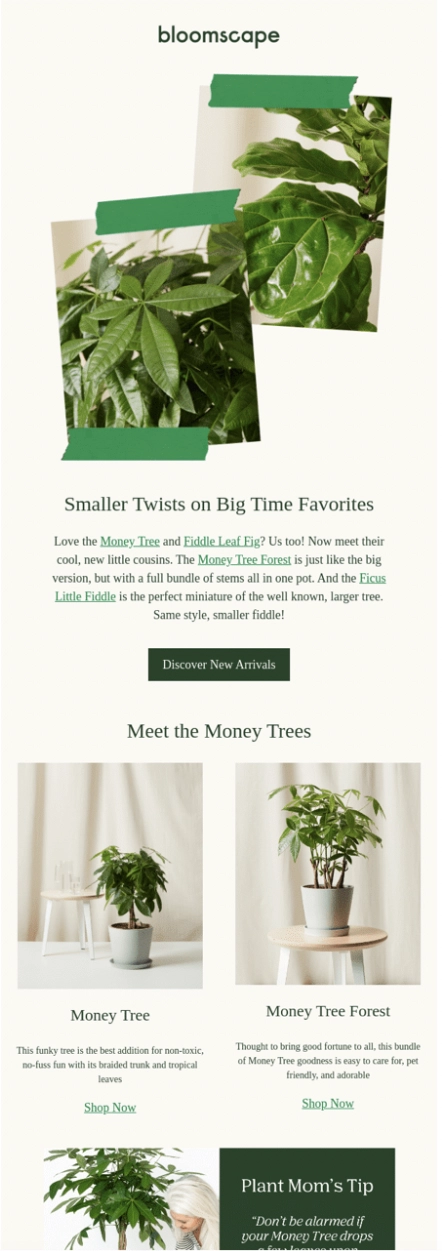
10. Bottom-of-the-funnel content
General Assembly is a company that offers next-level tech training for careers in software engineering, UX design, and more. Their email campaigns move engaged subscribers to the last stage of the funnel, where they can purchase a seat to an upcoming event.
In addition to offering industry expertise and educational content, they lay out titles, dates, and times for upcoming events and make it simple for readers to register for them. This strategy works well for subscribers who are consistently engaged and interact with your content regularly.
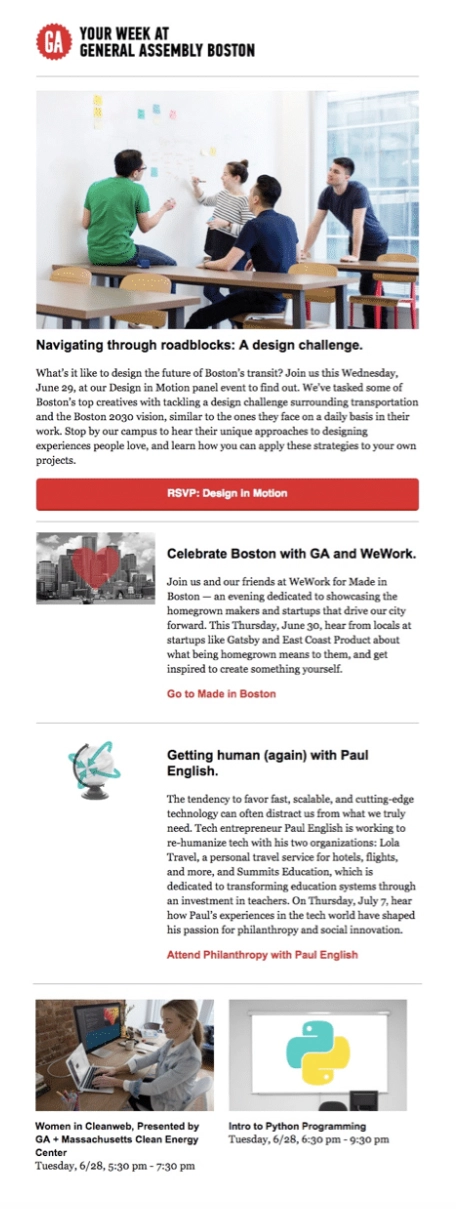
Dedicated landing pages that maximize your newsletter campaigns
As you contemplate your own email newsletter, remember to take your time. There are a lot of factors that play into whether someone will fill out your email subscription form and take the first step to becoming a loyal customer. Whether they come from your social media accounts, website, or paid ads, your goal is to keep them in your ecosystem by serving valuable information.
You may aim to focus on a specific niche, get existing content out to more eyeballs, or increase your ecommerce business, and choosing the right tools can help you meet your goals.
It’s good to remember that a successful newsletter often has dedicated landing pages as part of the strategy, as landing pages reinforce your message and can be that extra push in driving a conversion.
Instapage is the most powerful landing page builder on the market, with high-valued features like a drag and drop editor, pre-existing templates, an analytics dashboard, an AI content generator, and in-app A/B testing.
Instapage users love the ability to conduct A/B testing with Instapage Experiments. It is an intuitive feature that allows users to test variations of their landing page elements to understand what resonates best with their visitors. With Instapage Experiments, users can:
- Access heatmaps that provide a visual image of scroll depths, mouse movement, and on-page clicks. Using heatmaps, you can track your visitors’ behavior and improve element placement on your landing page accordingly
- Rewrite headlines and page copy using an AI generator based on the existing text, target audience, product description, and recommendations from API
- Compare elements like on-page videos, images, or text to see which is most engaging
- View deep A/B analytics in an easy-to-use dashboard
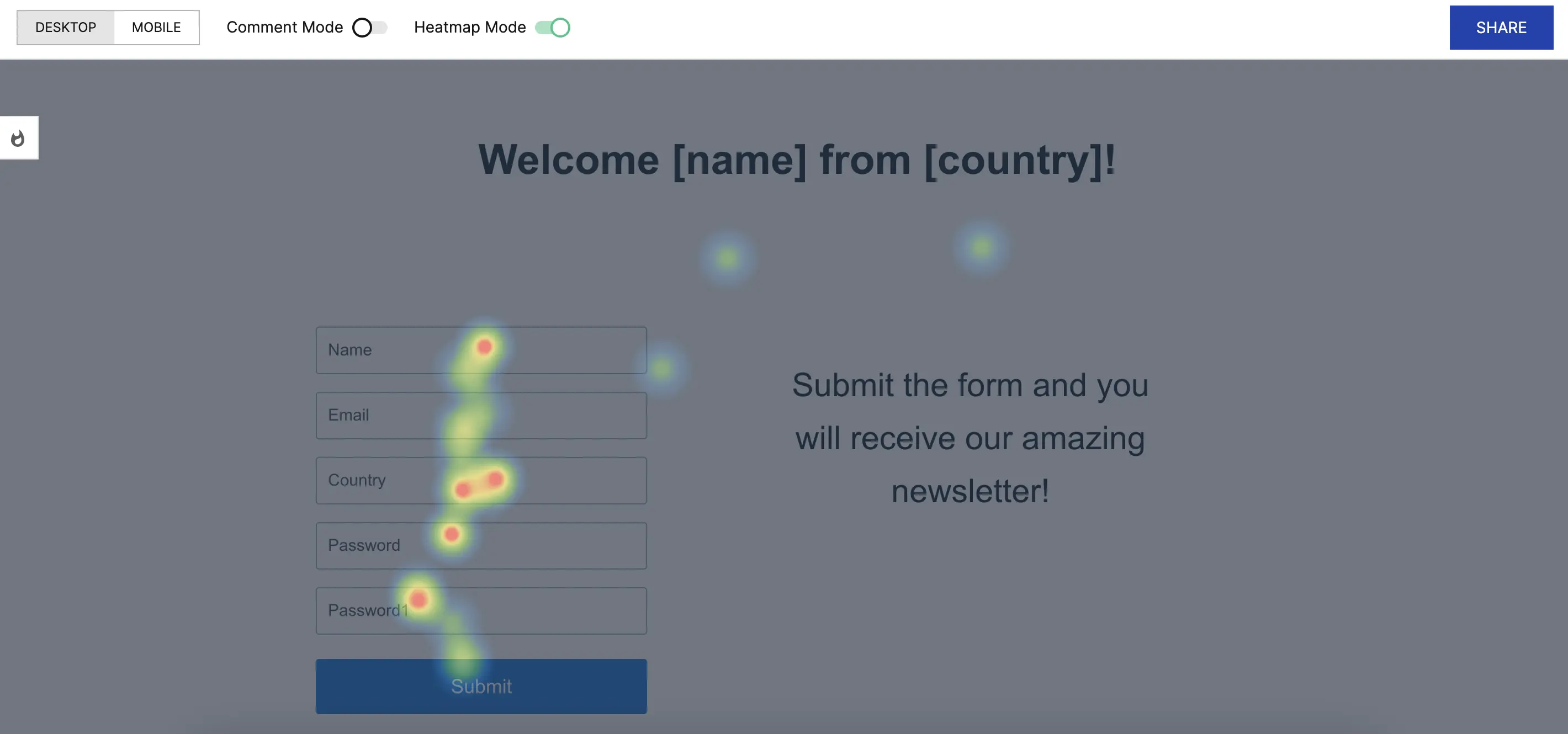
See more successful campaigns when you pair your emails with Instapage landing pages. Start a 14-day free trial of Instapage today.

Try the world's most advanced landing page platform with a risk-free trial.
